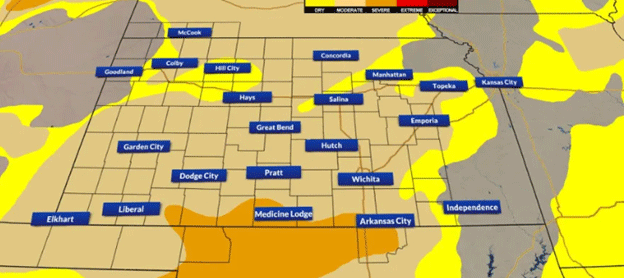Kansas, the top wheat-producing state in the U.S., is once again facing drought-related pressure during the 2024–2025 winter wheat season. While recent rainfall brought some relief, it has done little to reverse the effects of a prolonged dry spell. According to the U.S. Drought Monitor, 66% of Kansas is currently in moderate drought, up 11% from the previous week. The combination of moisture deficits, warm temperature swings, and disease pressures is creating a volatile outlook for the state’s wheat growers.
Moisture Deficit Deepens
The Kansas Wheat Commission reports that many regions have experienced nearly five months without significant precipitation, leading to topsoil and subsoil moisture depletion. This is particularly concerning as 46% of the winter wheat crop has already jointed, a key developmental stage where the number of kernels per head is determined.
Farmers like Josh Debes, from central Kansas, are witnessing clear signs of drought stress. “The wheat has looked progressively worse as we’ve missed all the rain,” he shared. Debes noted that soil moisture once found 4–5 inches deep is now absent, and bottom leaves of wheat plants are turning yellow, a classic indicator of drought stress.
These visual symptoms were echoed in the latest condition ratings from the National Agricultural Statistics Service (NASS):
| Condition | Last Week | This Week |
| Very Poor | 5% | 4% |
| Poor | 12% | 14% |
| Fair | 32% | 39% |
| Good | 45% | 38% |
| Excellent | 6% | 5% |
This reflects an 8% decline in wheat rated as good to excellent, down from 51% to 43% in just one week. The rapid deterioration is raising concerns about final yields.
Disease Complications
In addition to drought stress, disease symptoms may also be appearing, complicating field diagnostics. Jeanne Falk-Jones, an agronomy specialist from Kansas State University, warns that yellowing wheat could also indicate viral diseases such as Wheat Streak Mosaic Virus, Triticum Mosaic Virus, or High Plains Mosaic Virus. These diseases can exacerbate stress during dry conditions and further impact yields.
However, Falk-Jones also observed variability in field conditions, stating that some western Kansas fields still look strong, underlining the patchy nature of drought impacts across the state.
Broader Market Implications
Kansas typically produces around 300–350 million bushels of wheat annually, contributing nearly 20% of total U.S. production. Any significant yield reduction could have ripple effects in domestic and export markets. In 2023, U.S. wheat exports totaled 18.7 million metric tons, with Kansas wheat playing a vital role in supplying hard red winter wheat to key buyers such as Mexico, the Philippines, and Nigeria.
As of April 2025, global wheat prices remain sensitive to production reports from the U.S., Russia, and Australia. With Russia already forecasting a drop in production from last year, sustained drought in Kansas could lead to further upward pressure on global prices.
Kansas wheat farmers are navigating a difficult season marked by drought stress, disease threats, and unpredictable weather patterns. While parts of the state still hold promise, the majority face mounting challenges as jointing wheat requires critical moisture. Agronomists and farm managers must remain vigilant, monitor field symptoms closely, and adapt strategies quickly to minimize losses. As the season progresses, weather over the next 4–6 weeks will determine the real impact on yields — and potentially on the global wheat supply chain.
Error





